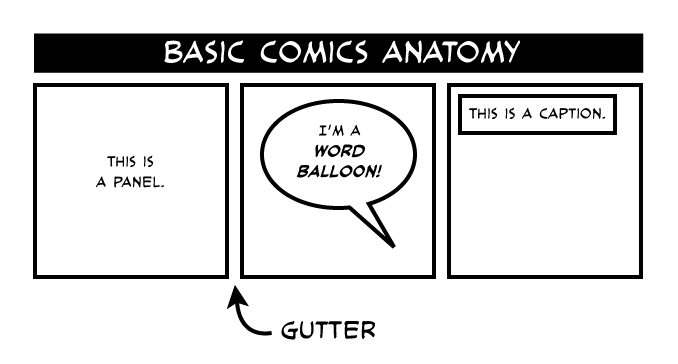Icon: an image that’s used to represent a person, place, thing, or an idea. They include symbols that represent concepts, ideas, and philosophies (i.e. American flag, peace sign) and also icons used for language, science, and communication purposes (multiplication sign, dollar sign, A, B, and C’s). Lastly, icons are also “pictures” used to represent an actual object, like a drawing of a shoe or a book.

Closure: observing parts of an image but perceiving the whole. An example of this would be in the comic below. We don’t see exactly what happens, but we assume that Joker dies in the end even though we don’t see it because his laughter and screeching stops in the last several panels.

Gutter: the space in-between panels. This plays an important part in comics as it allows for imagination to take place as the reader will take two images and combine them into one idea.

Moment-to-Moment: a transition between the panels of comics that requires very little closure. Therefore, you see every single step taking place. An example would be showing someone turning around step by step.


Action-to-action: a transition between panels of comics that show a single subject in distinct progressions. For example someone drunk driving through a highway and next panel would show him crashing into another car.


Subject-to-subject: a transition between panels in comics that takes us from one panel to another while staying within the scene or idea, but requires some reader participation. An example represented even in movies is when 2 actors might be having a conversation with each other and in one scene they focus on one actor and in the next couple seconds we are shown the other actor talking.

Scene-to-scene: a transition between panels in comics which take us across a significant distance of time and space. An example would be when stories have a time lapse and say “5 years later…” or show different seasons in each panel.

Aspect-to-aspect: a transition between panels in comics is when you have panels showing different aspects of a place, idea, or mood. An example would be showing the surroundings of a place so you get an idea what season it is, what the weather is like, how many birds are in the sky, and what people are wearing.


Non-sequitur: a transition between panels in comics that has no logical relationship between each of the panels. In this case, all the panels seem very random in which they might seem like they don’t belong to each other at all. You might have an image of a shoe in one panel, another of a picture of a snowman, then lastly a panel showing a drawing of an eagle.



Masking effect: Characters are normally realistic than their surroundings/backgrounds because the more simple a character is, the easier it is for us to identify with them. The more realistic a character becomes, we only see one person, however something like a smiley face can be applied to any of us. Therefore, other characters and scenery in a comic might look more realistic or have more details present than the main character, since it is the protagonist that we want to be focusing on and have all our attention on instead. This allows for more contrast to also be present. This can be seen throughout the panels of Tintin.



April 19, 2019 at 8:29 pm
I really like all of the examples you’ve included! I think there is a typo/editing error in ‘masking effect’! Otherwise, super great!